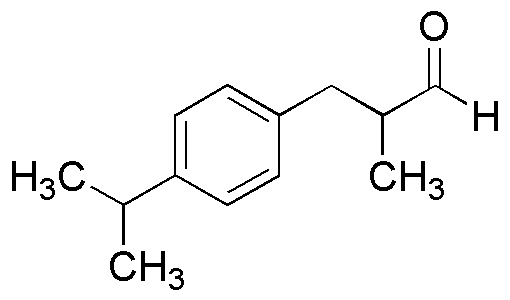2-Methyl-3-(p-isopropylphenyl)propionaldehyde is widely utilized in research focused on:
- Fragrance Industry: This compound is a key ingredient in perfumes and scented products, providing a pleasant aroma that enhances consumer appeal.
- Flavoring Agents: It is used in food products to impart a unique flavor profile, making it popular in the food and beverage industry.
- Cosmetics: The chemical serves as a fragrance component in various cosmetic formulations, contributing to the sensory experience of skincare and beauty products.
- Research Applications: In chemical research, it is utilized as a building block for synthesizing more complex organic compounds, aiding in the development of new materials.
- Industrial Applications: Its properties make it suitable for use in manufacturing processes where specific aromatic characteristics are desired, such as in the production of specialty chemicals.
General Information
Properties
Safety and Regulations
Applications
2-Methyl-3-(p-isopropylphenyl)propionaldehyde is widely utilized in research focused on:
- Fragrance Industry: This compound is a key ingredient in perfumes and scented products, providing a pleasant aroma that enhances consumer appeal.
- Flavoring Agents: It is used in food products to impart a unique flavor profile, making it popular in the food and beverage industry.
- Cosmetics: The chemical serves as a fragrance component in various cosmetic formulations, contributing to the sensory experience of skincare and beauty products.
- Research Applications: In chemical research, it is utilized as a building block for synthesizing more complex organic compounds, aiding in the development of new materials.
- Industrial Applications: Its properties make it suitable for use in manufacturing processes where specific aromatic characteristics are desired, such as in the production of specialty chemicals.
Documents
Safety Data Sheets (SDS)
The SDS provides comprehensive safety information on handling, storage, and disposal of the product.
Product Specification (PS)
The PS provides a comprehensive breakdown of the product’s properties, including chemical composition, physical state, purity, and storage requirements. It also details acceptable quality ranges and the product's intended applications.
Certificates of Analysis (COA)
Search for Certificates of Analysis (COA) by entering the products Lot Number. Lot and Batch Numbers can be found on a product’s label following the words ‘Lot’ or ‘Batch’.
*Catalog Number
*Lot Number
Certificates Of Origin (COO)
This COO confirms the country where the product was manufactured, and also details the materials and components used in it and whether it is derived from natural, synthetic, or other specific sources. This certificate may be required for customs, trade, and regulatory compliance.
*Catalog Number
*Lot Number
Safety Data Sheets (SDS)
The SDS provides comprehensive safety information on handling, storage, and disposal of the product.
DownloadProduct Specification (PS)
The PS provides a comprehensive breakdown of the product’s properties, including chemical composition, physical state, purity, and storage requirements. It also details acceptable quality ranges and the product's intended applications.
DownloadCertificates of Analysis (COA)
Search for Certificates of Analysis (COA) by entering the products Lot Number. Lot and Batch Numbers can be found on a product’s label following the words ‘Lot’ or ‘Batch’.
*Catalog Number
*Lot Number
Certificates Of Origin (COO)
This COO confirms the country where the product was manufactured, and also details the materials and components used in it and whether it is derived from natural, synthetic, or other specific sources. This certificate may be required for customs, trade, and regulatory compliance.


